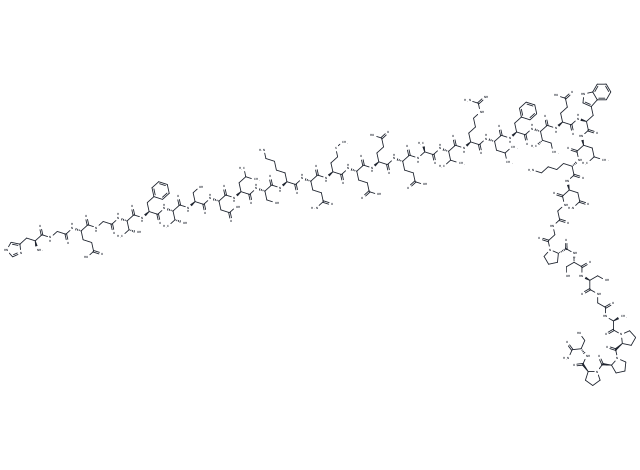Shopping Cart
- Remove All
 Your shopping cart is currently empty
Your shopping cart is currently empty

Exendin-4 (Exenatide) is a glucagon-like peptide-1 receptor (GLP-1) agonist (IC50: 3.22 nM). Exenatide is a 39 amino acid peptide. Compared to GLP-1, exenatide has a longer half-life of 2.4 hours.

| Pack Size | Price | Availability | Quantity |
|---|---|---|---|
| 1 mg | $57 | In Stock | |
| 2 mg | $83 | In Stock | |
| 5 mg | $137 | In Stock | |
| 10 mg | $197 | In Stock | |
| 25 mg | $297 | In Stock | |
| 50 mg | $443 | Inquiry | |
| 100 mg | $639 | Inquiry |
| Description | Exendin-4 (Exenatide) is a glucagon-like peptide-1 receptor (GLP-1) agonist (IC50: 3.22 nM). Exenatide is a 39 amino acid peptide. Compared to GLP-1, exenatide has a longer half-life of 2.4 hours. |
| Targets&IC50 | GLP1:3.22 nM |
| In vitro | In HUVECs, exendin-4 dose-dependently significantly increases NO production, eNOS phosphorylation and GTPCH1 level[2]. Exendin-4 shows cytotoxic effects to MCF-7 breast cancer cells (IC50 5 μM) at 48 hours [3]. |
| In vivo | In ob/ob mice, the treatment of exendin-4 improve serum ALT and reduce serum glucose, insulin levels and calculated HOMA scores compared with control. In the final 4 weeks of the study period, exendin-4-treated ob/ob mice sustain an obvious reduction in the net weight gain[4]. Animals treated with exendin-4 have more pyknotic nuclei, more pancreatic acinar inflammation and weigh significantly less than control rats[5]. Exenatide leads to dose-dependent relaxation of rat thoracic aorta, which is evoked via the GLP-1 receptor and is mediated mainly by H2S but also by CO and NO[6]. |
| Alias | Exenatide |
| Molecular Weight | 4186.57 |
| Formula | C184H282N50O60S |
| Cas No. | 141758-74-9 |
| Smiles | CC[C@H](C)[C@H](NC(=O)[C@H](Cc1ccccc1)NC(=O)[C@H](CC(C)C)NC(=O)[C@H](CCCNC(N)=N)NC(=O)[C@@H](NC(=O)[C@H](C)NC(=O)[C@H](CCC(O)=O)NC(=O)[C@H](CCC(O)=O)NC(=O)[C@H](CCC(O)=O)NC(=O)[C@H](CCSC)NC(=O)[C@H](CCC(N)=O)NC(=O)[C@H](CCCCN)NC(=O)[C@H](CO)NC(=O)[C@H](CC(C)C)NC(=O)[C@H](CC(O)=O)NC(=O)[C@H](CO)NC(=O)[C@@H](NC(=O)[C@H](Cc1ccccc1)NC(=O)[C@@H](NC(=O)CNC(=O)[C@H](CCC(O)=O)NC(=O)CNC(=O)[C@@H](N)Cc1c[nH]cn1)[C@@H](C)O)[C@@H](C)O)C(C)C)C(=O)N[C@@H](CCC(O)=O)C(=O)N[C@@H](Cc1c[nH]c2ccccc12)C(=O)N[C@@H](CC(C)C)C(=O)N[C@@H](CCCCN)C(=O)N[C@@H](CC(N)=O)C(=O)NCC(=O)NCC(=O)N1CCC[C@H]1C(=O)N[C@@H](CO)C(=O)N[C@@H](CO)C(=O)NCC(=O)N[C@@H](C)C(=O)N1CCC[C@H]1C(=O)N1CCC[C@H]1C(=O)N1CCC[C@H]1C(=O)N[C@@H](CO)C(N)=O |
| Relative Density. | no data available |
| Storage | keep away from moisture,store at low temperature | Powder: -20°C for 3 years | In solvent: -80°C for 1 year | Shipping with blue ice. |
| Solubility Information | DMSO: 10 mM, Sonication is recommended. H2O: 1.23 mg/mL (0.29 mM), Sonication and heating are recommended. |

Copyright © 2015-2025 TargetMol Chemicals Inc. All Rights Reserved.